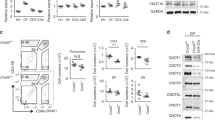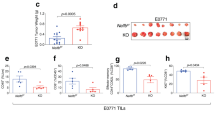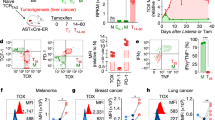Abstract
ENGAGEMENT of the T-cell antigen receptor (TCR) on immature thymic T cells induces death by apoptosis1–3. Although several lines of evidence indicate that apoptosis requires de novo gene expression, little is known about the molecular pathways that mediate this response. Here we show that nur77 (refs 4–7), a zinc-finger transcription factor, is expressed in response to TCR engagement in immature T cells and T-cell hybrids. Antisense inhibition of nur77 expression prevents apoptosis in TCR-stimulated cells. nur77 is also expressed in response to mitogens, but in this case transcription is regulated by 5' upstream elements that are distinct from those used for induction of apoptosis. In addition, polyadenylation is only observed on nur77 transcripts found in condemned cells. These data support a role for nur77 in cell death that may be distinct from that of activation.
This is a preview of subscription content, access via your institution
Access options
Subscribe to this journal
Receive 51 print issues and online access
$199.00 per year
only $3.90 per issue
Buy this article
- Purchase on Springer Link
- Instant access to full article PDF
Prices may be subject to local taxes which are calculated during checkout
Similar content being viewed by others
References
MacDonald, H. R. & Lees, R. K. Nature 343, 642–644 (1990).
Swat, W., Ignatowicz, L., von Boehmer, H. & Kiselow, P. Nature 351, 150–153 (1991).
Smith, C. A., Williams, G. T., Kingston, R., Jenkinson, E. J. & Owen, J. J. T. Nature 337, 181–184 (1989).
Hazel, T. G., Nathans, D. & Lau, L. F. Proc. natn. Acad. Sci. U.S.A. 85, 8444–8448 (1988).
Milbrandt, J. Neuron 1, 183–188 (1988).
Varnum, B. C., Lim, R. W. & Herschman, H. R. Oncogene 4, 1263–1265 (1989).
Ryseck, R.-P., MacDonald-Bravo, H., Mattei, M.-G., Ruppert, S. & Bravo, R. EMBO. J. 8, 3327–3335 (1989).
Ucker, D. S., Ashwell, J. D. & Nickas, G. J. Immun. 143, 3461–3469 (1989).
Murphy, K. M., Heimberger, A. B. & Loh, D. Y. Science 250, 1720–1722 (1990).
Schwartz, L. M., Kosz, L. & Kay, B. K. Proc. natn. Acad. Sci. U.S.A. 87, 6594–6598 (1990).
Haskins, K., Kubo, R., White, J., Pigeon, M., Kappler, J. & Marrack, P. J. exp. Med. 157, 1149–1169 (1983).
Ashwell, J. D., Cunningham, R. E., Noguchi, P. D. & Hernandez, D. J. exp. Med. 165, 173–194 (1987).
Wyllie, A. H. Nature 284, 555–556 (1980).
Shaw, G. & Kamen, R. Cell 46, 659–667 (1986).
Wilson, T. & Treisman, R. Nature 336, 396–399 (1988).
Monroe, D. & Jacobson, A. Molec. cell. Biol. 10, 3441–3455 (1990).
Zhu, L. et al. Genes Dev. 7, 1111–1125 (1993).
Shi, Y. et al. Science 257, 212–214 (1992).
Evan, G. I. et al. Cell 69, 119–128 (1992).
Shi, Y. et al. J. immun. 144, 3326–3333 (1990).
Leo, O., Foo, M., Sachs, D. H., Samelson, L. E. & Bluestone, J. A. Proc. natn. Acad. Sci. U.S.A. 84, 1374–1378 (1987).
Ausebel, F. M. et al. Current Protocols in Molecular Biology (Wiley Interscience, New York, 1987).
Author information
Authors and Affiliations
Rights and permissions
About this article
Cite this article
Liu, ZG., Smith, S., McLaughlin, K. et al. Apoptotic signals delivered through the T-cell receptor of a T-cell hybrid require the immediate–early gene nur77. Nature 367, 281–284 (1994). https://doi.org/10.1038/367281a0
Received:
Accepted:
Issue Date:
DOI: https://doi.org/10.1038/367281a0
This article is cited by
-
Construction of Metastasis-Specific Regulation Network in Ovarian Cancer Based on Prognostic Stemness-Related Signatures
Reproductive Sciences (2023)
-
Regulation of effector and memory CD8 + T cell differentiation: a focus on orphan nuclear receptor NR4A family, transcription factor, and metabolism
Immunologic Research (2023)
-
Sexual dimorphism in rat thymic involution: a correlation with thymic oxidative status and inflammation
Biogerontology (2019)
-
Nuclear pore complex-mediated modulation of TCR signaling is required for naïve CD4+ T cell homeostasis
Nature Immunology (2018)
-
Cell cycle and apoptosis regulation by NFAT transcription factors: new roles for an old player
Cell Death & Disease (2016)
Comments
By submitting a comment you agree to abide by our Terms and Community Guidelines. If you find something abusive or that does not comply with our terms or guidelines please flag it as inappropriate.



